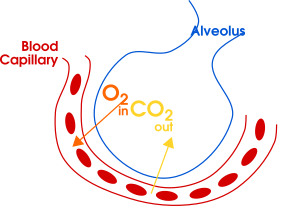Exchange of gases facts for kids
Imagine your body is like a busy factory that needs fresh air to keep running! Gas exchange is how living things, like you, animals, and plants, swap important gases with their surroundings. This amazing process allows organisms to take in the gases they need to live and get rid of the waste gases they don't.
Most animals, including humans, breathe in oxygen and breathe out carbon dioxide. Plants also breathe in oxygen and breathe out carbon dioxide, just like us, especially at night. However, during the day, plants do something special called photosynthesis. They use carbon dioxide from the air to make their own food, and as a bonus, they release oxygen back into the air! This helps keep the air balanced for everyone.
Contents
How Humans Breathe and Exchange Gases
Your body needs oxygen to get energy from the food you eat. This energy helps you run, play, think, and even sleep! When your body uses oxygen, it creates carbon dioxide as a waste product. Gas exchange is how your body makes sure you always have enough oxygen and get rid of the carbon dioxide.
The Journey of Air
When you take a breath, air travels through your nose or mouth, down your windpipe (called the trachea), and into your lungs. Your lungs are like two big sponges in your chest. Inside your lungs, the air goes into smaller and smaller tubes, like branches of a tree.
Tiny Air Sacs: Alveoli
At the very end of these tiny tubes are millions of super-small air sacs called alveoli. If you could spread out all your alveoli, they would cover a tennis court! This huge surface area is perfect for gas exchange. Each alveolus is surrounded by tiny blood vessels called capillaries.
Swapping Gases: Diffusion
This is where the magic happens! The walls of the alveoli and the capillaries are incredibly thin, like a single sheet of paper. This thinness allows gases to move easily between the air in your lungs and your blood. This movement is called diffusion.
- Oxygen from the fresh air you breathed in diffuses (moves) from the alveoli into the capillaries. It then hitches a ride on your red blood cells, which carry it all over your body.
- Carbon dioxide, the waste gas from your body, diffuses from the capillaries into the alveoli. From there, it travels back up the tubes in your lungs and out of your body when you breathe out.
Why Oxygen is Important
Once oxygen is in your blood, it travels to every single cell in your body. Your cells use this oxygen in a process called aerobic respiration. This is like a tiny power plant inside each cell that burns food (like sugar) with oxygen to create energy. Without enough oxygen, your cells can't make the energy they need, and your body can't work properly.
Gas Exchange in Other Living Things
Gas exchange isn't just for humans! All living things need to swap gases with their environment to survive.
Plants: Breathing and Making Food
Plants are amazing because they do two types of gas exchange:
- Respiration: Just like us, plants take in oxygen and release carbon dioxide all day and night to get energy for their cells.
- Photosynthesis: During the day, when there's sunlight, plants take in carbon dioxide and release oxygen. They use the carbon dioxide, water, and sunlight to make their own food (sugars). This is why plants are so important for keeping our air fresh!
Animals with Different Ways to Breathe
Not all animals have lungs like humans.
- Fish use gills to take oxygen from water. Water flows over their gills, and oxygen diffuses into their blood.
- Insects have tiny holes called spiracles on their bodies. Air enters these holes and travels through a network of tubes directly to their cells.
- Amphibians like frogs can breathe through their skin, especially when they are underwater, as well as with lungs.
Gas exchange is a fundamental process that keeps life going on Earth, from the smallest bacteria to the largest whales!


